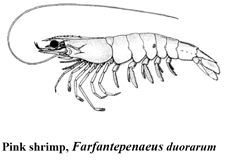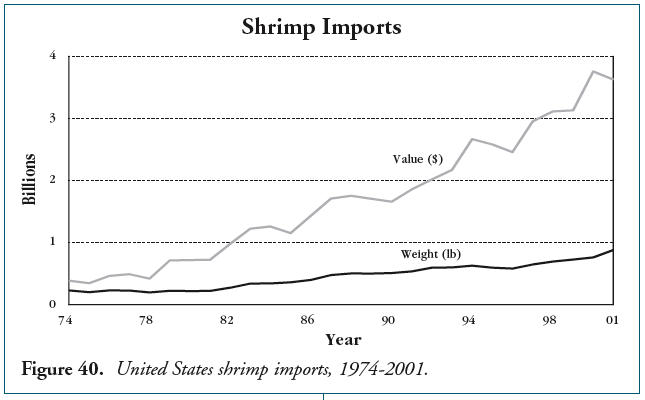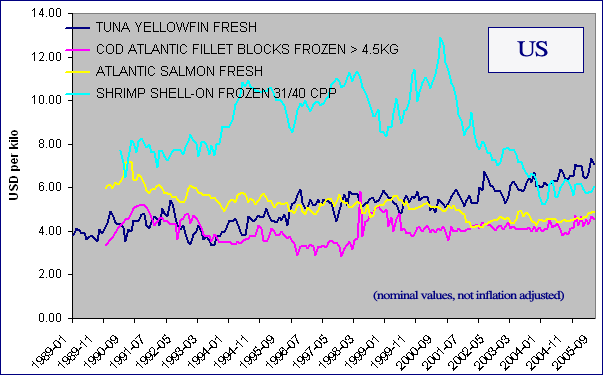
Invertebrates: The Other Food Source
The problem of over fishing is not limited to fish. We catch and eat many other marine animals including shrimp, crabs, clams, lobsters, oysters, and scallops. Where do these creatures live? What do they eat? What eats them? How many are there? How are they affected by coastal development?
Lets Concentrate On One Class: Shrimp. Shrimp remained the top choice for seafood in the United States at 4.1 pounds per person in 2007 according to NOAA.
Commercial Shrimp Species Gulf of Mexico
Shrimp live part of their life in lagoons, bays, and mangrove areas and in deeper water offshore. In Texas, the commercial shrimp species are Brown Shrimp, White Shrimp, and Pink Shrimp.
Brown Shrimp: Sexual maturity for brown shrimp is near 4.5 inches for males and 6.5 inches for female. Brown shrimp spawning takes place in Gulf waters ranging from 151 to 299 feet. There is some indication that during the winter, brown shrimp post-larvae may remain offshore in the Gulf for some period before moving into estuaries in early spring. Peak influx of post-larval brown shrimp to estuarine waters is February–April. After entering bays, brown shrimp tend to be found in significantly higher densities in vegetated marsh areas. As brown shrimp grow from juvenile to sub-adults, they begin to feed more on detritus and benthic organisms such as polychaete worms and amphipods. During the juvenile to sub-adult phase, brown shrimp enter deeper bay waters and eventually emigrate from bays to the Gulf. This emigration is generally in association with a full moon and strong tidal cycles from May through August with peaks from May to July.
White Shrimp: Size at sexual maturity for white shrimp is 6.0 inches for males and 6.5 inches for females. White shrimp spawning occurs offshore in depths ranging from 23 to 108 feet from March to September. Peak influx of post-larval white shrimp to estuarine bay waters is during summer. As white shrimp grow they begin to move into deeper open bay waters, preferring soft mud or peat bottoms. Decreasing water temperature accelerates emigration of white shrimp to the Gulf. Offshore movements peak from September to December. Along the south-central Texas coast, shrimp move southward during cool months and northward during spring.
Pink Shrimp: Minimum size at sexual maturity for male pink shrimp is 2.9 inches and 3.3 inches for females. Pink shrimp spawning occurs offshore in depths ranging from about 13 to 164 feet. Although spawning occurs all year, activity increases as water temperature rises. Peaks in spawning occur in late spring, summer and early fall. Peaks of immigration of pink shrimp post-larvae into nursery areas occur in the spring and fall. Dense sea grass beds appear to be important to both post-larval and juvenile pink shrimp. Emigration of pink shrimp occurs throughout the spring, summer, and fall and seems to be correlated with full moon ebb tides. Some pink shrimp over-winter in Texas bays, residing in estuaries for up to nine months.
Quotes from The Texas Shrimp Fishery: A report to the Governor and the 77th Legislature of Texas. The link will download a 5 MByte pdf file published by the Texas Parks and Wildlife Department (2002).
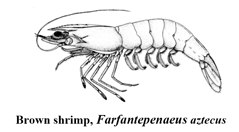
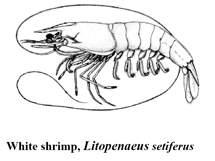
Images from Florida Fish and Wildlife Commission.The life cycles of brown, white and pink shrimp are similar.
They spend part of their life in estuaries, bays and the Gulf of Mexico. Spawning occurs in the Gulf of Mexico (a on the map below). One female shrimp releases 100,000 to 1,000,000 eggs that hatch within 24 hours. The young shrimp develop through several larval stages as they are carried shoreward by winds and currents (b, c, and d). By the time the young shrimp (post-larvae) reach the gulf passes and enter the bays, they are one-fourth inch long, transparent and have a shrimp-like appearance (e).Post-larvae drift or migrate to nursery areas within shallow bays, tidal creeks, and marshes where food and protection necessary for growth and survival are available (f). There they acquire color and become bottom dwellers. If conditions are favorable in nursery areas, the young shrimp grow rapidly and soon move to the deeper water of the bays (g).
When shrimp reach juvenile and sub-adult stages (3-5 inches long) they usually migrate from the bays to the Gulf of Mexico where they mature and complete their life cycles (h). Most shrimp will spend the rest of their life in the Gulf. The fishery for them begins when the shrimp are two to four months old and continues for the rest of their lives. If not caught by anglers or eaten by fish, they may live to be two years old.
Quotes from Texas Parks and Wildlife Department.
Shrimp Life Cycle
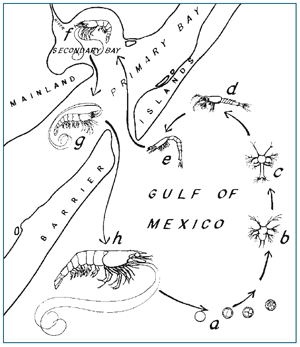
Left: Life cycle of shrimp
showing distribution with depth. From Shrimp
News International. Right:
Life cycle of shrimp showing distribution in the horizontal off the
Texas Coast. a) shrimp eggs. b) nauplius larva. c) protozoea. d)
mysis. e) postmysis. f) juvenile shrimp. g) adolescent shrimp. h)
mature adult shrimp. From The
Texas Shrimp Fishery: A report to the Governor and the 77th Legislature
of Texas. The link will download a 5 MByte pdf file published
by the Texas Parks and Wildlife Department (2002): page 3.
Shrimping Issues
Commercial shrimping is an important industry along the Gulf coast and the east coast of the USA from the Carolinas southward. Demand for shrimp eventually lead to over fishing, which caused environmental problems.
- Over fishing of shrimp reduced the numbers of shrimp.
- Reduced shrimp populations reduced the number of fish. Many fish
eat juvenile and adult shrimp.
The truth about fishing in 1963 is, it is going down so fast [on the Texas coast] that it's time for somebody to alert those who are interested in its future to learn what is causing this decline ... The decline in fishing is caused by several things. The principal reason is the scarcity of food. Everything from mites to elephants and from larvae to whales must have food to survive. For us, bread is the staff of life. For fish, it is shrimp.
Farley (2002).
- Shrimp nets catch many fish that are discarded. This is called by-catch. Four to eight pounds of fish are killed and discarded for each pound of shrimp caught.
- Shrimp nets pulled along the bottom disrupt the ecology of the bottom, reducing the population of bottom fish and other animals.
- Shrimp nets, until recently, caught many turtles. The requirement that all nets have Turtle Excluding Devices TED has reduced the number of turtles caught and accidentally killed.
Shrimp populations are influenced by offshore fishing as well as by bay fishing. And, they are influenced by coastal pollution, destruction of marshes and mangroves, and coastal development. In Texas, shrimp fishing has the greatest influence.
To reduce over fishing shrimp and the environmental destruction related to over fishing, the Texas Parks and Wildlife Department has spent $12.8 million since 1995 to buy back shrimp-fishing licenses using funds produced by a $3 surcharge on recreational fishing licenses. Through January 2009, the department has bought back 1,978 licenses, helping reduce the number of licenses from 3,231 in 1995 to 1,253. By 2008, peak bay shrimping effort has decreased by 91 percent since 1994 according to Texas Department of Parks and Wildlife.
Shrimp Farming
The over fishing of shrimp in many regions, the rising demand for shrimp, and the high prices paid for shrimp have led to major expansion of shrimp farming. Thailand is one of the major sources of farmed shrimp. The U.S. currently imports around 80% of the shrimp consumed. In Texas, about half the shrimp sold today are raised on farms. The remainder come from such areas as the Texas gulf coast, which supports a major shrimp industry ($194,000,000 in 1999 compared with $9,000,000 for all fish from the Texas coastal waters). For the latest statistics on US shrimp imports see the Fish Information Network's Report. Click on the latest date on the right column.
From The Texas Shrimp Fishery: A report to the Governor and the 77th Legislature of Texas. The link will download a 5 MByte pdf file published by the Texas Parks and Wildlife Department (2002).
US seafood price indicators.
From GlobeFish.
What factors influence shrimp farming?
Americans now eat more shrimp per person than any other marine food product.
During 2001, shrimp for the first time surpassed canned tuna as the most “popular” seafood item, with the per capita consumption of shrimp being 3.4 lbs compared to 2.9 lbs for canned tuna. Apparent domestic consumption of shrimp during this same period was 1.3 billion pounds (heads-off weight), up from 750,000 lbs in 1991. To meet this growing demand, imports of shrimp products have become the dominant source of product for the domestic market. Of the total domestic supply of shrimp during 2001, imported product represented 85%, the remainder being provided by domestic harvesters.
Charles Adams and Sal Versaggi (2004). U.S. Shrimp Import Controversy. In: Conference on International Agricultural Trade Disputes: Case Studies in North America.
For a good overview of shrimp farming read the article Wiki: Shrimp Farming.
How does shrimp farming influence the environment?
Dr. Louis Landesman has written
in 1994 on the negative
influence of aquaculture on the environment.
The environmental problems associated with shrimp farming include:
- Habitat loss. Shrimp farms are located in coastal areas, replacing mangroves, wetlands, and other essential habitats of marine organisms.
- Waste water from the farms pollute coastal waters.
- Over fishing of brood stock in offshore waters.
- Spread of viral diseases from farmed shrimp to native shrimp.
Disease outbreaks on US shrimp farmers-like Taura Syndrome Virus (TSV) in Texas in 1995 and 1996 and in South Carolina in 1996- has raised concerns among aquacuturists and wild harvest fishermen alike, as well as among regulators charged with overseeing these industries. Although TSV and other disease recently found in cultured shrimp pose no threat to humans, they can be devastating to the shrimp themselves and to the people whose livelihoods depend on them. The 1995 TSV outbreak in Texas resulted in the loss of more than 95% of the P. vannamei crop. Disease events in South Carolina in 1996 resulted in estimated losses of 30%~ 50% on affected farms. Although there is little evidence that it has been or ever will be a problem, especially considering the significant economic value of the industry. Currently, the US harvests approximately 200 million pounds (tails) of shrimp each year and imports another 600 million pounds (tails), collectively valued at more than $3 billion (Fish Farming News, 1998). However, exposing native shrimp populations to these diseases could decimate current populations and set off a chain reaction throughout the coastal ecosystem.
From Coastal Shrimp Farming in Texas.
- Introduction of exotic species for culture which later escape into
the surrounding ecosystem.
Texas marine shrimp culture has traditionally relied on non native shellfish species (exotic species) because consumer demand for large species of shrimp has been increasing. Exotic shrimp grows rapidly, and their ability to survive in confined conditions is much higher than native species in an open ocean.
From Coastal Shrimp Farming in Texas.
Shrimp farming needs a constant supply of shrimp larvae or brood stock, shrimp ponds replace mangroves, the growing shrimp need lots of high protein food, some of which comes from the sea, and they produce waste water. Shrimp farmers can reduce environmental damage, and by raising shrimp reduce the need to fish wild shrimp. Find out more at the Texas Shrimp Farming site.
I have searched for more up-to-date information, but everything I found was from the early to mid 1990s. Because environmental problems also lead to failure of the shrimp farms, many of the worst practices are being replaced by better practices.
Louisiana Fisheries has a web page giving a simple description of shrimp ecology.
References
Farley, B. (2002). Fishing Yesterday's Gulf Coast. College Station, Texas A&M University Press.
Revised on: 29 May, 2017

